University Economics Report: Becoming an Economist, Course ID
VerifiedAdded on 2022/10/01
|13
|2914
|374
Report
AI Summary
This report provides an economic analysis of Japan, examining its current state through various macroeconomic indicators. It begins with a theoretical background, discussing the significance of GDP, inflation, unemployment, and international trade in assessing a nation's economic performance. The analysis then focuses on Japan, exploring its real GDP, inflation rates, unemployment levels, and trade balance from 2015 to 2019. The report highlights trends such as the fluctuating GDP growth, the recovery of price levels after a period of deflation, and the decline in unemployment rates. It also discusses the impact of factors like public sector investment, monetary easing policies, and trade wars on Japan's economic performance. The report concludes by summarizing the key findings and their implications for Japan's economic outlook, emphasizing the country's resilience and the challenges it faces in maintaining sustainable growth and achieving its inflation targets.
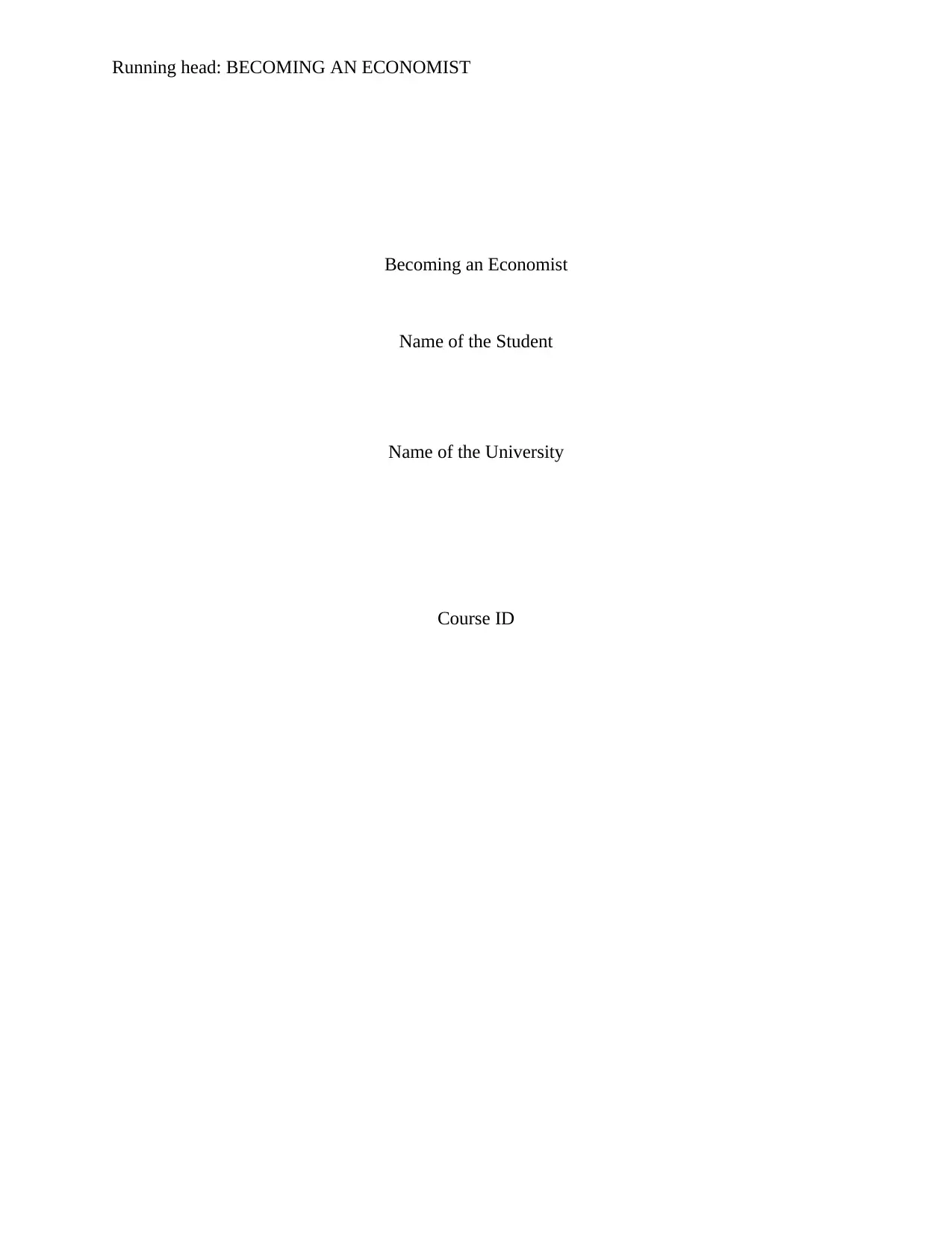
Running head: BECOMING AN ECONOMIST
Becoming an Economist
Name of the Student
Name of the University
Course ID
Becoming an Economist
Name of the Student
Name of the University
Course ID
Paraphrase This Document
Need a fresh take? Get an instant paraphrase of this document with our AI Paraphraser
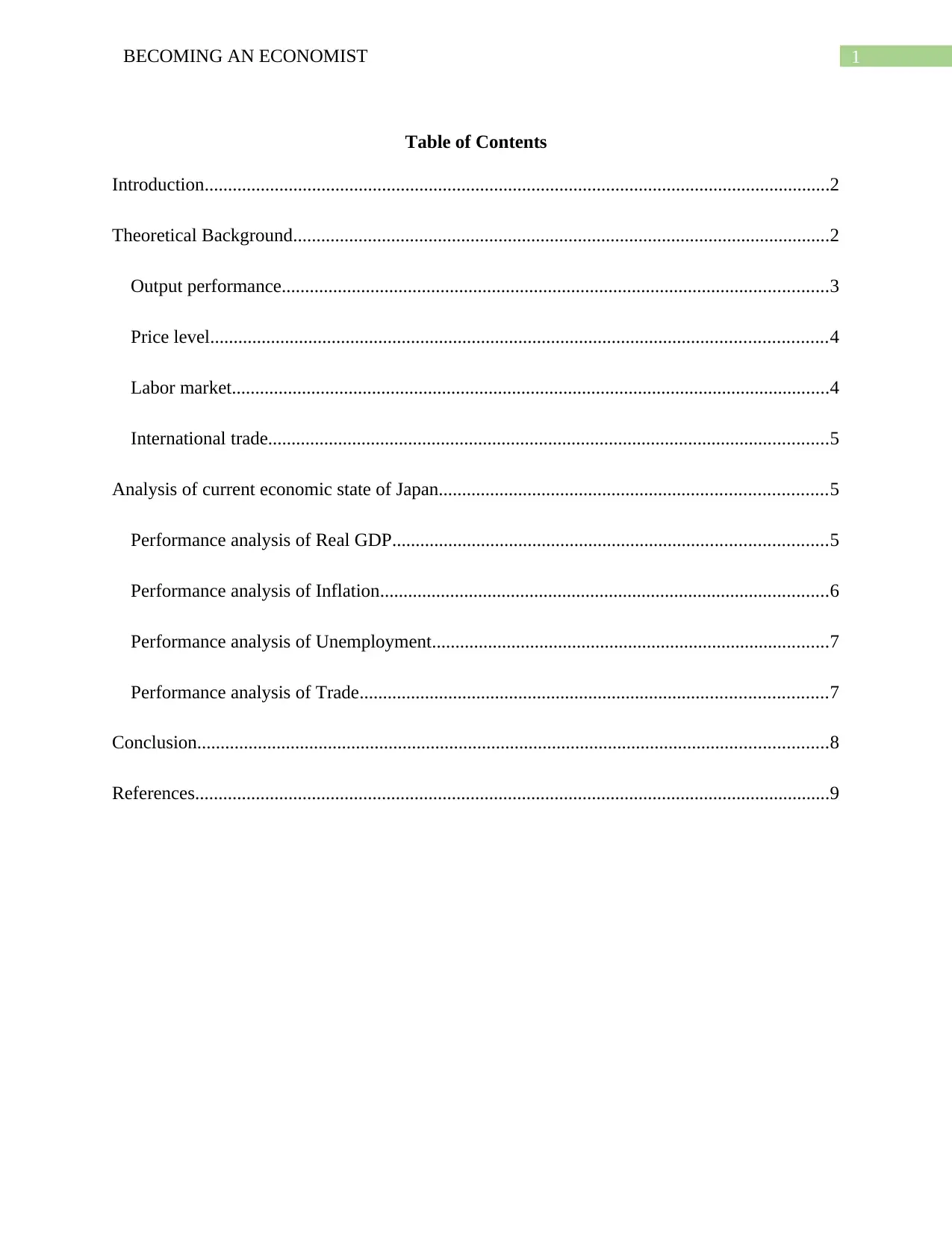
1BECOMING AN ECONOMIST
Table of Contents
Introduction......................................................................................................................................2
Theoretical Background...................................................................................................................2
Output performance.....................................................................................................................3
Price level....................................................................................................................................4
Labor market................................................................................................................................4
International trade........................................................................................................................5
Analysis of current economic state of Japan...................................................................................5
Performance analysis of Real GDP.............................................................................................5
Performance analysis of Inflation................................................................................................6
Performance analysis of Unemployment.....................................................................................7
Performance analysis of Trade....................................................................................................7
Conclusion.......................................................................................................................................8
References........................................................................................................................................9
Table of Contents
Introduction......................................................................................................................................2
Theoretical Background...................................................................................................................2
Output performance.....................................................................................................................3
Price level....................................................................................................................................4
Labor market................................................................................................................................4
International trade........................................................................................................................5
Analysis of current economic state of Japan...................................................................................5
Performance analysis of Real GDP.............................................................................................5
Performance analysis of Inflation................................................................................................6
Performance analysis of Unemployment.....................................................................................7
Performance analysis of Trade....................................................................................................7
Conclusion.......................................................................................................................................8
References........................................................................................................................................9
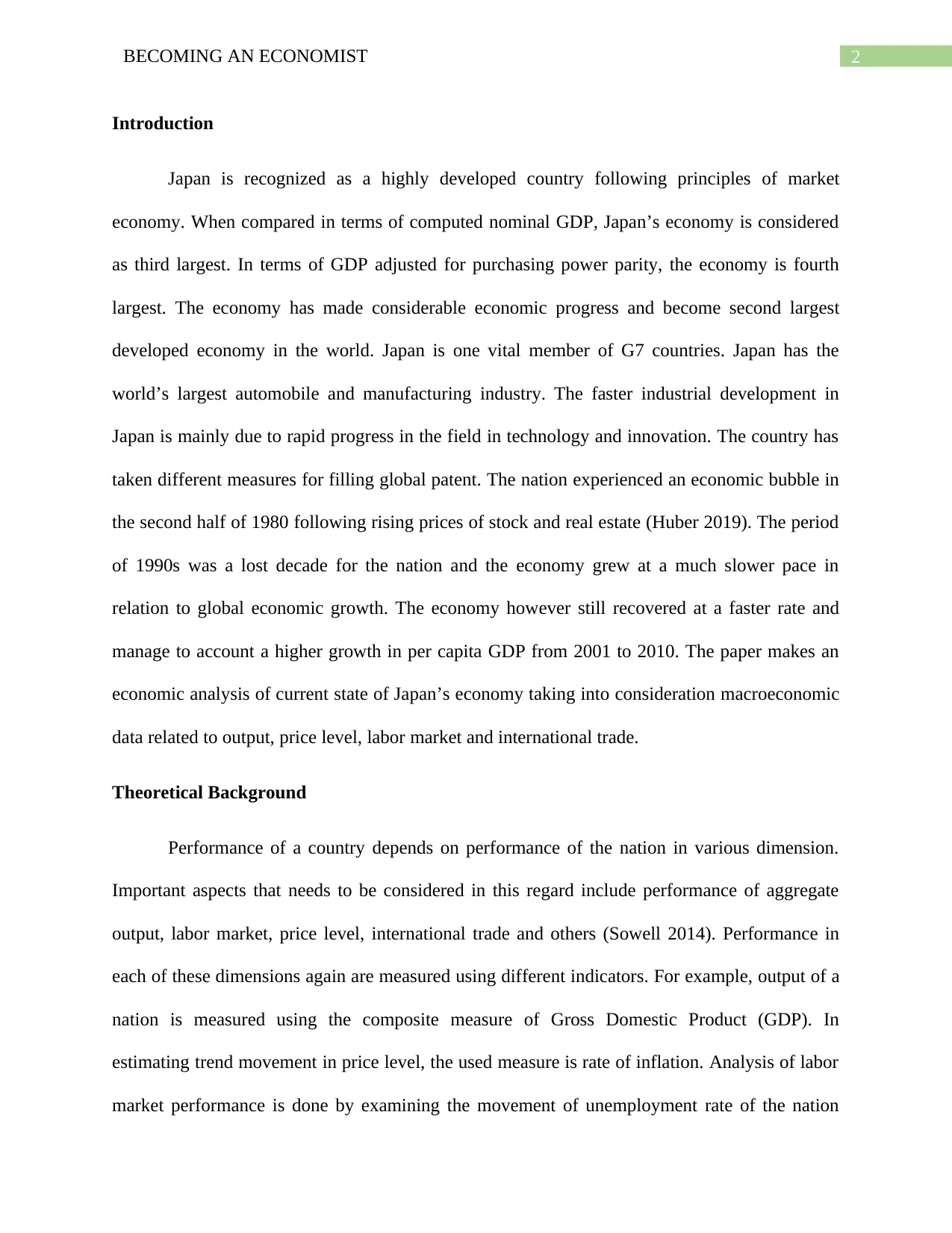
2BECOMING AN ECONOMIST
Introduction
Japan is recognized as a highly developed country following principles of market
economy. When compared in terms of computed nominal GDP, Japan’s economy is considered
as third largest. In terms of GDP adjusted for purchasing power parity, the economy is fourth
largest. The economy has made considerable economic progress and become second largest
developed economy in the world. Japan is one vital member of G7 countries. Japan has the
world’s largest automobile and manufacturing industry. The faster industrial development in
Japan is mainly due to rapid progress in the field in technology and innovation. The country has
taken different measures for filling global patent. The nation experienced an economic bubble in
the second half of 1980 following rising prices of stock and real estate (Huber 2019). The period
of 1990s was a lost decade for the nation and the economy grew at a much slower pace in
relation to global economic growth. The economy however still recovered at a faster rate and
manage to account a higher growth in per capita GDP from 2001 to 2010. The paper makes an
economic analysis of current state of Japan’s economy taking into consideration macroeconomic
data related to output, price level, labor market and international trade.
Theoretical Background
Performance of a country depends on performance of the nation in various dimension.
Important aspects that needs to be considered in this regard include performance of aggregate
output, labor market, price level, international trade and others (Sowell 2014). Performance in
each of these dimensions again are measured using different indicators. For example, output of a
nation is measured using the composite measure of Gross Domestic Product (GDP). In
estimating trend movement in price level, the used measure is rate of inflation. Analysis of labor
market performance is done by examining the movement of unemployment rate of the nation
Introduction
Japan is recognized as a highly developed country following principles of market
economy. When compared in terms of computed nominal GDP, Japan’s economy is considered
as third largest. In terms of GDP adjusted for purchasing power parity, the economy is fourth
largest. The economy has made considerable economic progress and become second largest
developed economy in the world. Japan is one vital member of G7 countries. Japan has the
world’s largest automobile and manufacturing industry. The faster industrial development in
Japan is mainly due to rapid progress in the field in technology and innovation. The country has
taken different measures for filling global patent. The nation experienced an economic bubble in
the second half of 1980 following rising prices of stock and real estate (Huber 2019). The period
of 1990s was a lost decade for the nation and the economy grew at a much slower pace in
relation to global economic growth. The economy however still recovered at a faster rate and
manage to account a higher growth in per capita GDP from 2001 to 2010. The paper makes an
economic analysis of current state of Japan’s economy taking into consideration macroeconomic
data related to output, price level, labor market and international trade.
Theoretical Background
Performance of a country depends on performance of the nation in various dimension.
Important aspects that needs to be considered in this regard include performance of aggregate
output, labor market, price level, international trade and others (Sowell 2014). Performance in
each of these dimensions again are measured using different indicators. For example, output of a
nation is measured using the composite measure of Gross Domestic Product (GDP). In
estimating trend movement in price level, the used measure is rate of inflation. Analysis of labor
market performance is done by examining the movement of unemployment rate of the nation
⊘ This is a preview!⊘
Do you want full access?
Subscribe today to unlock all pages.

Trusted by 1+ million students worldwide
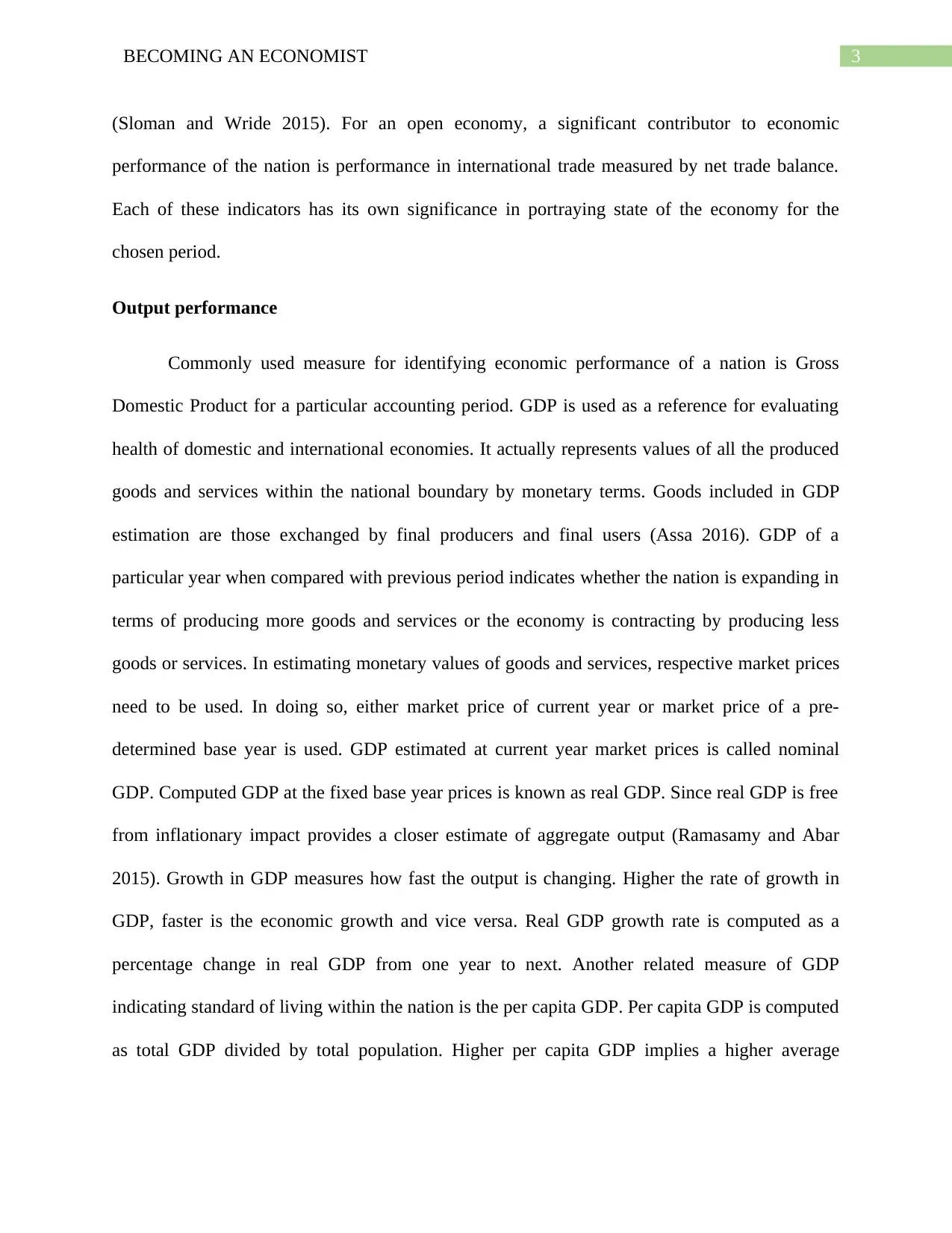
3BECOMING AN ECONOMIST
(Sloman and Wride 2015). For an open economy, a significant contributor to economic
performance of the nation is performance in international trade measured by net trade balance.
Each of these indicators has its own significance in portraying state of the economy for the
chosen period.
Output performance
Commonly used measure for identifying economic performance of a nation is Gross
Domestic Product for a particular accounting period. GDP is used as a reference for evaluating
health of domestic and international economies. It actually represents values of all the produced
goods and services within the national boundary by monetary terms. Goods included in GDP
estimation are those exchanged by final producers and final users (Assa 2016). GDP of a
particular year when compared with previous period indicates whether the nation is expanding in
terms of producing more goods and services or the economy is contracting by producing less
goods or services. In estimating monetary values of goods and services, respective market prices
need to be used. In doing so, either market price of current year or market price of a pre-
determined base year is used. GDP estimated at current year market prices is called nominal
GDP. Computed GDP at the fixed base year prices is known as real GDP. Since real GDP is free
from inflationary impact provides a closer estimate of aggregate output (Ramasamy and Abar
2015). Growth in GDP measures how fast the output is changing. Higher the rate of growth in
GDP, faster is the economic growth and vice versa. Real GDP growth rate is computed as a
percentage change in real GDP from one year to next. Another related measure of GDP
indicating standard of living within the nation is the per capita GDP. Per capita GDP is computed
as total GDP divided by total population. Higher per capita GDP implies a higher average
(Sloman and Wride 2015). For an open economy, a significant contributor to economic
performance of the nation is performance in international trade measured by net trade balance.
Each of these indicators has its own significance in portraying state of the economy for the
chosen period.
Output performance
Commonly used measure for identifying economic performance of a nation is Gross
Domestic Product for a particular accounting period. GDP is used as a reference for evaluating
health of domestic and international economies. It actually represents values of all the produced
goods and services within the national boundary by monetary terms. Goods included in GDP
estimation are those exchanged by final producers and final users (Assa 2016). GDP of a
particular year when compared with previous period indicates whether the nation is expanding in
terms of producing more goods and services or the economy is contracting by producing less
goods or services. In estimating monetary values of goods and services, respective market prices
need to be used. In doing so, either market price of current year or market price of a pre-
determined base year is used. GDP estimated at current year market prices is called nominal
GDP. Computed GDP at the fixed base year prices is known as real GDP. Since real GDP is free
from inflationary impact provides a closer estimate of aggregate output (Ramasamy and Abar
2015). Growth in GDP measures how fast the output is changing. Higher the rate of growth in
GDP, faster is the economic growth and vice versa. Real GDP growth rate is computed as a
percentage change in real GDP from one year to next. Another related measure of GDP
indicating standard of living within the nation is the per capita GDP. Per capita GDP is computed
as total GDP divided by total population. Higher per capita GDP implies a higher average
Paraphrase This Document
Need a fresh take? Get an instant paraphrase of this document with our AI Paraphraser

4BECOMING AN ECONOMIST
income and therefore a better standard of living. It is a very useful measure for comparing living
standard between two nations.
income and therefore a better standard of living. It is a very useful measure for comparing living
standard between two nations.
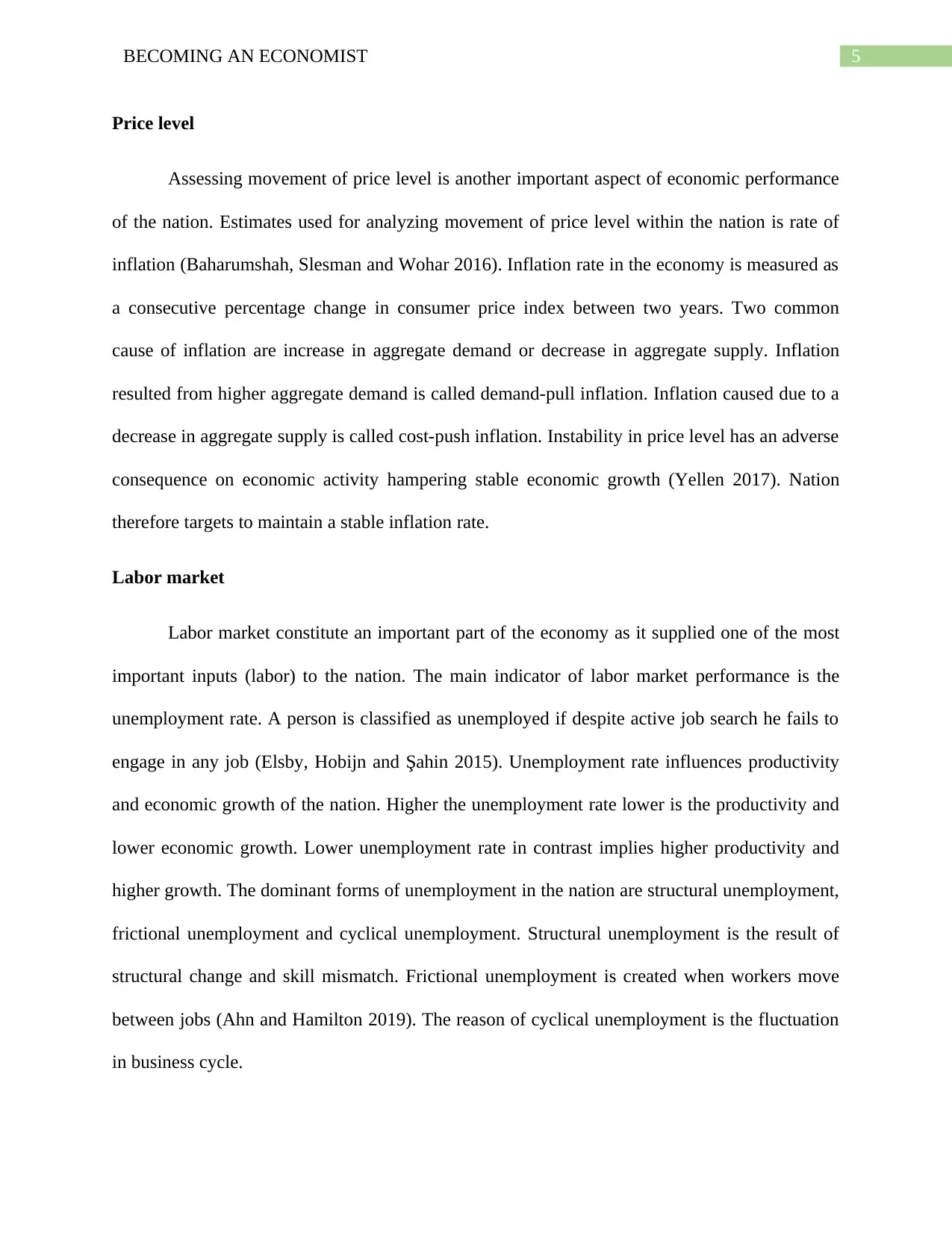
5BECOMING AN ECONOMIST
Price level
Assessing movement of price level is another important aspect of economic performance
of the nation. Estimates used for analyzing movement of price level within the nation is rate of
inflation (Baharumshah, Slesman and Wohar 2016). Inflation rate in the economy is measured as
a consecutive percentage change in consumer price index between two years. Two common
cause of inflation are increase in aggregate demand or decrease in aggregate supply. Inflation
resulted from higher aggregate demand is called demand-pull inflation. Inflation caused due to a
decrease in aggregate supply is called cost-push inflation. Instability in price level has an adverse
consequence on economic activity hampering stable economic growth (Yellen 2017). Nation
therefore targets to maintain a stable inflation rate.
Labor market
Labor market constitute an important part of the economy as it supplied one of the most
important inputs (labor) to the nation. The main indicator of labor market performance is the
unemployment rate. A person is classified as unemployed if despite active job search he fails to
engage in any job (Elsby, Hobijn and Şahin 2015). Unemployment rate influences productivity
and economic growth of the nation. Higher the unemployment rate lower is the productivity and
lower economic growth. Lower unemployment rate in contrast implies higher productivity and
higher growth. The dominant forms of unemployment in the nation are structural unemployment,
frictional unemployment and cyclical unemployment. Structural unemployment is the result of
structural change and skill mismatch. Frictional unemployment is created when workers move
between jobs (Ahn and Hamilton 2019). The reason of cyclical unemployment is the fluctuation
in business cycle.
Price level
Assessing movement of price level is another important aspect of economic performance
of the nation. Estimates used for analyzing movement of price level within the nation is rate of
inflation (Baharumshah, Slesman and Wohar 2016). Inflation rate in the economy is measured as
a consecutive percentage change in consumer price index between two years. Two common
cause of inflation are increase in aggregate demand or decrease in aggregate supply. Inflation
resulted from higher aggregate demand is called demand-pull inflation. Inflation caused due to a
decrease in aggregate supply is called cost-push inflation. Instability in price level has an adverse
consequence on economic activity hampering stable economic growth (Yellen 2017). Nation
therefore targets to maintain a stable inflation rate.
Labor market
Labor market constitute an important part of the economy as it supplied one of the most
important inputs (labor) to the nation. The main indicator of labor market performance is the
unemployment rate. A person is classified as unemployed if despite active job search he fails to
engage in any job (Elsby, Hobijn and Şahin 2015). Unemployment rate influences productivity
and economic growth of the nation. Higher the unemployment rate lower is the productivity and
lower economic growth. Lower unemployment rate in contrast implies higher productivity and
higher growth. The dominant forms of unemployment in the nation are structural unemployment,
frictional unemployment and cyclical unemployment. Structural unemployment is the result of
structural change and skill mismatch. Frictional unemployment is created when workers move
between jobs (Ahn and Hamilton 2019). The reason of cyclical unemployment is the fluctuation
in business cycle.
⊘ This is a preview!⊘
Do you want full access?
Subscribe today to unlock all pages.

Trusted by 1+ million students worldwide
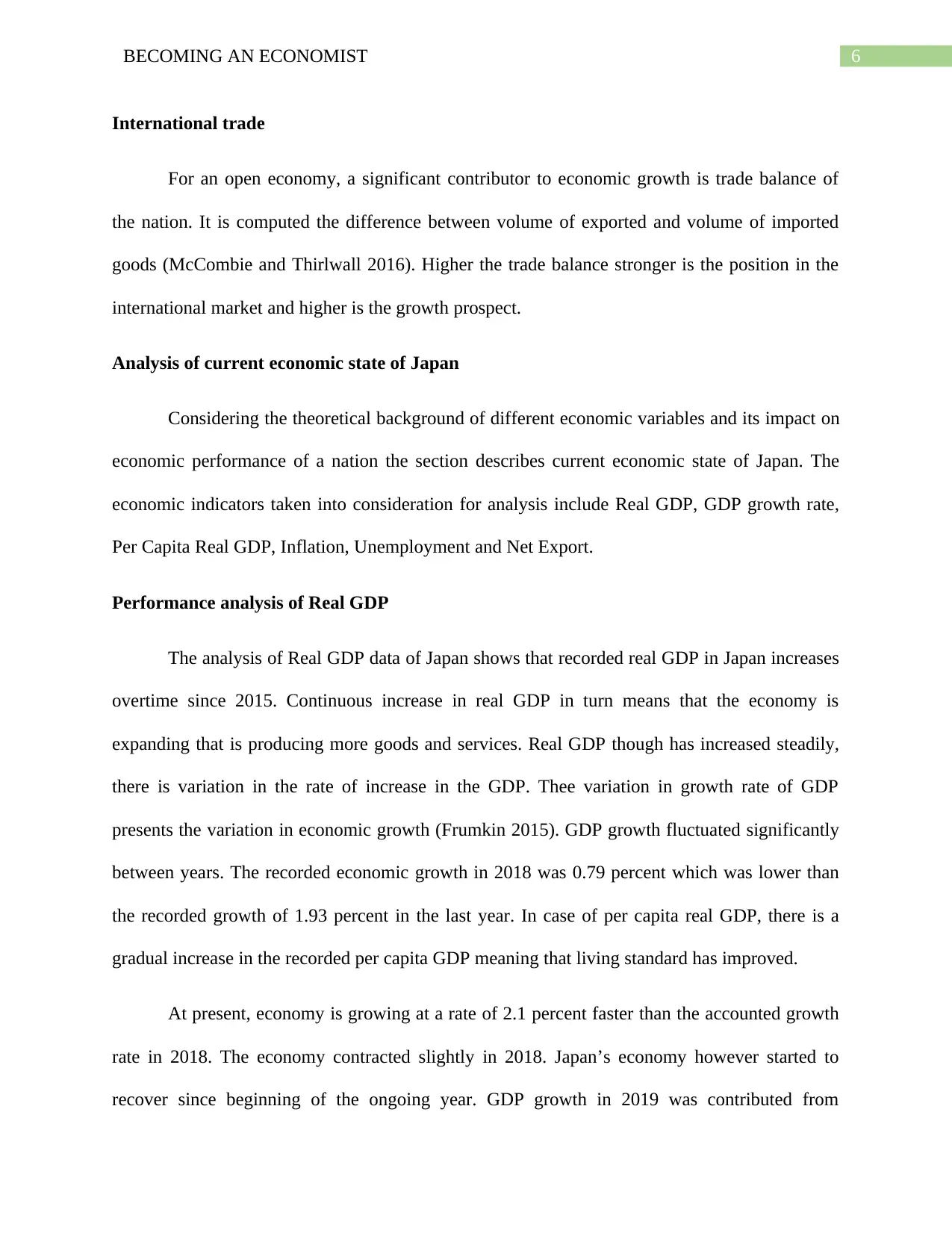
6BECOMING AN ECONOMIST
International trade
For an open economy, a significant contributor to economic growth is trade balance of
the nation. It is computed the difference between volume of exported and volume of imported
goods (McCombie and Thirlwall 2016). Higher the trade balance stronger is the position in the
international market and higher is the growth prospect.
Analysis of current economic state of Japan
Considering the theoretical background of different economic variables and its impact on
economic performance of a nation the section describes current economic state of Japan. The
economic indicators taken into consideration for analysis include Real GDP, GDP growth rate,
Per Capita Real GDP, Inflation, Unemployment and Net Export.
Performance analysis of Real GDP
The analysis of Real GDP data of Japan shows that recorded real GDP in Japan increases
overtime since 2015. Continuous increase in real GDP in turn means that the economy is
expanding that is producing more goods and services. Real GDP though has increased steadily,
there is variation in the rate of increase in the GDP. Thee variation in growth rate of GDP
presents the variation in economic growth (Frumkin 2015). GDP growth fluctuated significantly
between years. The recorded economic growth in 2018 was 0.79 percent which was lower than
the recorded growth of 1.93 percent in the last year. In case of per capita real GDP, there is a
gradual increase in the recorded per capita GDP meaning that living standard has improved.
At present, economy is growing at a rate of 2.1 percent faster than the accounted growth
rate in 2018. The economy contracted slightly in 2018. Japan’s economy however started to
recover since beginning of the ongoing year. GDP growth in 2019 was contributed from
International trade
For an open economy, a significant contributor to economic growth is trade balance of
the nation. It is computed the difference between volume of exported and volume of imported
goods (McCombie and Thirlwall 2016). Higher the trade balance stronger is the position in the
international market and higher is the growth prospect.
Analysis of current economic state of Japan
Considering the theoretical background of different economic variables and its impact on
economic performance of a nation the section describes current economic state of Japan. The
economic indicators taken into consideration for analysis include Real GDP, GDP growth rate,
Per Capita Real GDP, Inflation, Unemployment and Net Export.
Performance analysis of Real GDP
The analysis of Real GDP data of Japan shows that recorded real GDP in Japan increases
overtime since 2015. Continuous increase in real GDP in turn means that the economy is
expanding that is producing more goods and services. Real GDP though has increased steadily,
there is variation in the rate of increase in the GDP. Thee variation in growth rate of GDP
presents the variation in economic growth (Frumkin 2015). GDP growth fluctuated significantly
between years. The recorded economic growth in 2018 was 0.79 percent which was lower than
the recorded growth of 1.93 percent in the last year. In case of per capita real GDP, there is a
gradual increase in the recorded per capita GDP meaning that living standard has improved.
At present, economy is growing at a rate of 2.1 percent faster than the accounted growth
rate in 2018. The economy contracted slightly in 2018. Japan’s economy however started to
recover since beginning of the ongoing year. GDP growth in 2019 was contributed from
Paraphrase This Document
Need a fresh take? Get an instant paraphrase of this document with our AI Paraphraser
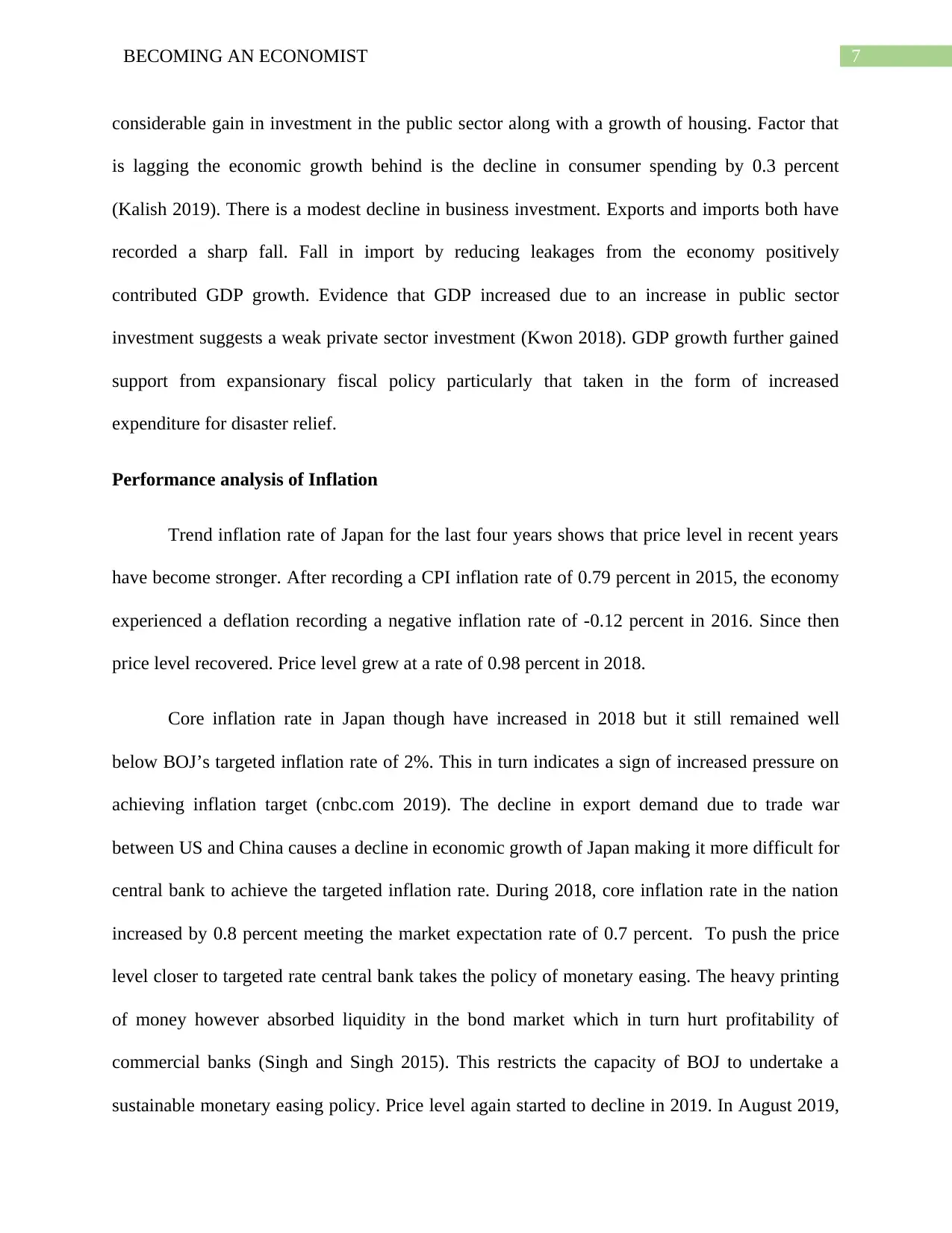
7BECOMING AN ECONOMIST
considerable gain in investment in the public sector along with a growth of housing. Factor that
is lagging the economic growth behind is the decline in consumer spending by 0.3 percent
(Kalish 2019). There is a modest decline in business investment. Exports and imports both have
recorded a sharp fall. Fall in import by reducing leakages from the economy positively
contributed GDP growth. Evidence that GDP increased due to an increase in public sector
investment suggests a weak private sector investment (Kwon 2018). GDP growth further gained
support from expansionary fiscal policy particularly that taken in the form of increased
expenditure for disaster relief.
Performance analysis of Inflation
Trend inflation rate of Japan for the last four years shows that price level in recent years
have become stronger. After recording a CPI inflation rate of 0.79 percent in 2015, the economy
experienced a deflation recording a negative inflation rate of -0.12 percent in 2016. Since then
price level recovered. Price level grew at a rate of 0.98 percent in 2018.
Core inflation rate in Japan though have increased in 2018 but it still remained well
below BOJ’s targeted inflation rate of 2%. This in turn indicates a sign of increased pressure on
achieving inflation target (cnbc.com 2019). The decline in export demand due to trade war
between US and China causes a decline in economic growth of Japan making it more difficult for
central bank to achieve the targeted inflation rate. During 2018, core inflation rate in the nation
increased by 0.8 percent meeting the market expectation rate of 0.7 percent. To push the price
level closer to targeted rate central bank takes the policy of monetary easing. The heavy printing
of money however absorbed liquidity in the bond market which in turn hurt profitability of
commercial banks (Singh and Singh 2015). This restricts the capacity of BOJ to undertake a
sustainable monetary easing policy. Price level again started to decline in 2019. In August 2019,
considerable gain in investment in the public sector along with a growth of housing. Factor that
is lagging the economic growth behind is the decline in consumer spending by 0.3 percent
(Kalish 2019). There is a modest decline in business investment. Exports and imports both have
recorded a sharp fall. Fall in import by reducing leakages from the economy positively
contributed GDP growth. Evidence that GDP increased due to an increase in public sector
investment suggests a weak private sector investment (Kwon 2018). GDP growth further gained
support from expansionary fiscal policy particularly that taken in the form of increased
expenditure for disaster relief.
Performance analysis of Inflation
Trend inflation rate of Japan for the last four years shows that price level in recent years
have become stronger. After recording a CPI inflation rate of 0.79 percent in 2015, the economy
experienced a deflation recording a negative inflation rate of -0.12 percent in 2016. Since then
price level recovered. Price level grew at a rate of 0.98 percent in 2018.
Core inflation rate in Japan though have increased in 2018 but it still remained well
below BOJ’s targeted inflation rate of 2%. This in turn indicates a sign of increased pressure on
achieving inflation target (cnbc.com 2019). The decline in export demand due to trade war
between US and China causes a decline in economic growth of Japan making it more difficult for
central bank to achieve the targeted inflation rate. During 2018, core inflation rate in the nation
increased by 0.8 percent meeting the market expectation rate of 0.7 percent. To push the price
level closer to targeted rate central bank takes the policy of monetary easing. The heavy printing
of money however absorbed liquidity in the bond market which in turn hurt profitability of
commercial banks (Singh and Singh 2015). This restricts the capacity of BOJ to undertake a
sustainable monetary easing policy. Price level again started to decline in 2019. In August 2019,
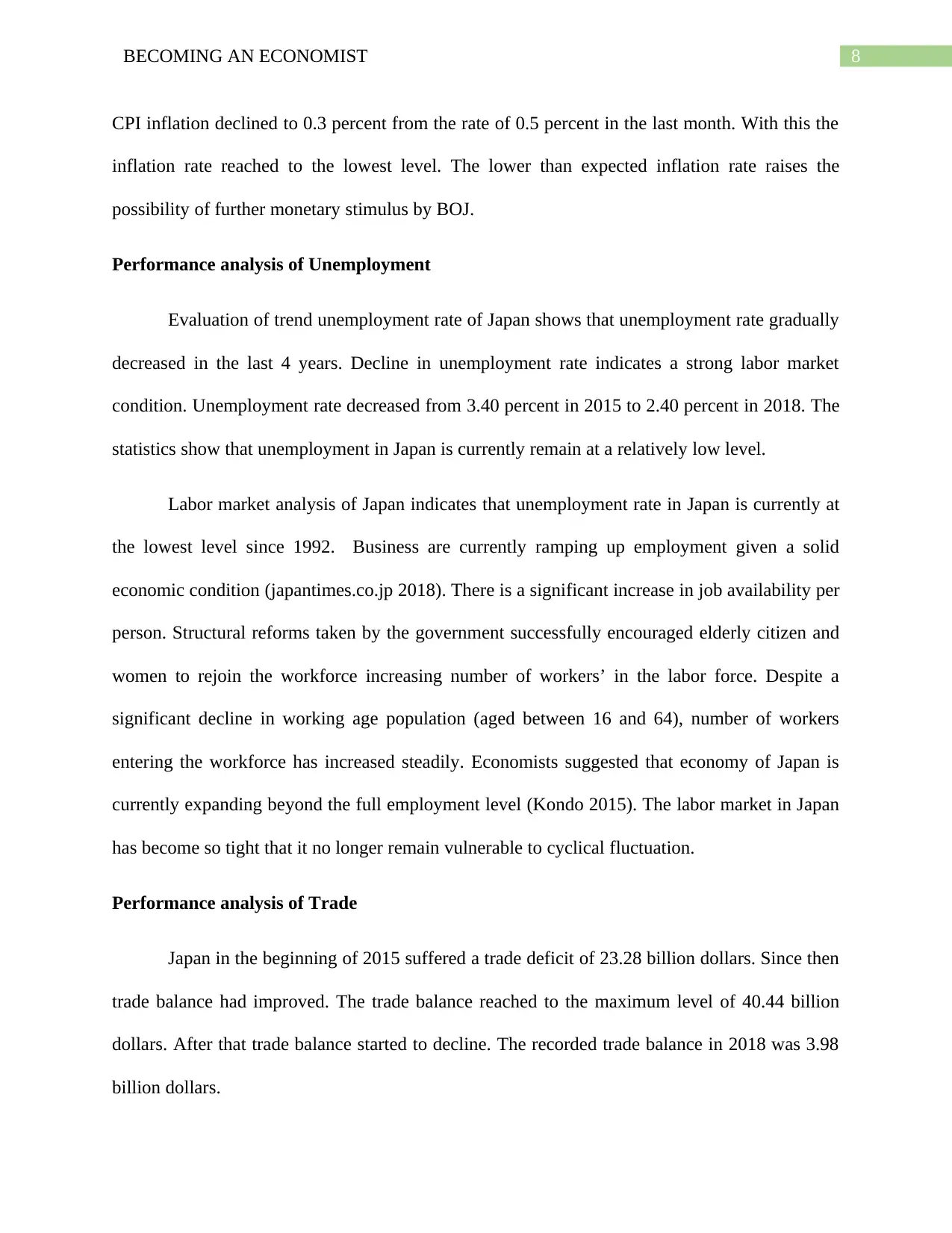
8BECOMING AN ECONOMIST
CPI inflation declined to 0.3 percent from the rate of 0.5 percent in the last month. With this the
inflation rate reached to the lowest level. The lower than expected inflation rate raises the
possibility of further monetary stimulus by BOJ.
Performance analysis of Unemployment
Evaluation of trend unemployment rate of Japan shows that unemployment rate gradually
decreased in the last 4 years. Decline in unemployment rate indicates a strong labor market
condition. Unemployment rate decreased from 3.40 percent in 2015 to 2.40 percent in 2018. The
statistics show that unemployment in Japan is currently remain at a relatively low level.
Labor market analysis of Japan indicates that unemployment rate in Japan is currently at
the lowest level since 1992. Business are currently ramping up employment given a solid
economic condition (japantimes.co.jp 2018). There is a significant increase in job availability per
person. Structural reforms taken by the government successfully encouraged elderly citizen and
women to rejoin the workforce increasing number of workers’ in the labor force. Despite a
significant decline in working age population (aged between 16 and 64), number of workers
entering the workforce has increased steadily. Economists suggested that economy of Japan is
currently expanding beyond the full employment level (Kondo 2015). The labor market in Japan
has become so tight that it no longer remain vulnerable to cyclical fluctuation.
Performance analysis of Trade
Japan in the beginning of 2015 suffered a trade deficit of 23.28 billion dollars. Since then
trade balance had improved. The trade balance reached to the maximum level of 40.44 billion
dollars. After that trade balance started to decline. The recorded trade balance in 2018 was 3.98
billion dollars.
CPI inflation declined to 0.3 percent from the rate of 0.5 percent in the last month. With this the
inflation rate reached to the lowest level. The lower than expected inflation rate raises the
possibility of further monetary stimulus by BOJ.
Performance analysis of Unemployment
Evaluation of trend unemployment rate of Japan shows that unemployment rate gradually
decreased in the last 4 years. Decline in unemployment rate indicates a strong labor market
condition. Unemployment rate decreased from 3.40 percent in 2015 to 2.40 percent in 2018. The
statistics show that unemployment in Japan is currently remain at a relatively low level.
Labor market analysis of Japan indicates that unemployment rate in Japan is currently at
the lowest level since 1992. Business are currently ramping up employment given a solid
economic condition (japantimes.co.jp 2018). There is a significant increase in job availability per
person. Structural reforms taken by the government successfully encouraged elderly citizen and
women to rejoin the workforce increasing number of workers’ in the labor force. Despite a
significant decline in working age population (aged between 16 and 64), number of workers
entering the workforce has increased steadily. Economists suggested that economy of Japan is
currently expanding beyond the full employment level (Kondo 2015). The labor market in Japan
has become so tight that it no longer remain vulnerable to cyclical fluctuation.
Performance analysis of Trade
Japan in the beginning of 2015 suffered a trade deficit of 23.28 billion dollars. Since then
trade balance had improved. The trade balance reached to the maximum level of 40.44 billion
dollars. After that trade balance started to decline. The recorded trade balance in 2018 was 3.98
billion dollars.
⊘ This is a preview!⊘
Do you want full access?
Subscribe today to unlock all pages.

Trusted by 1+ million students worldwide
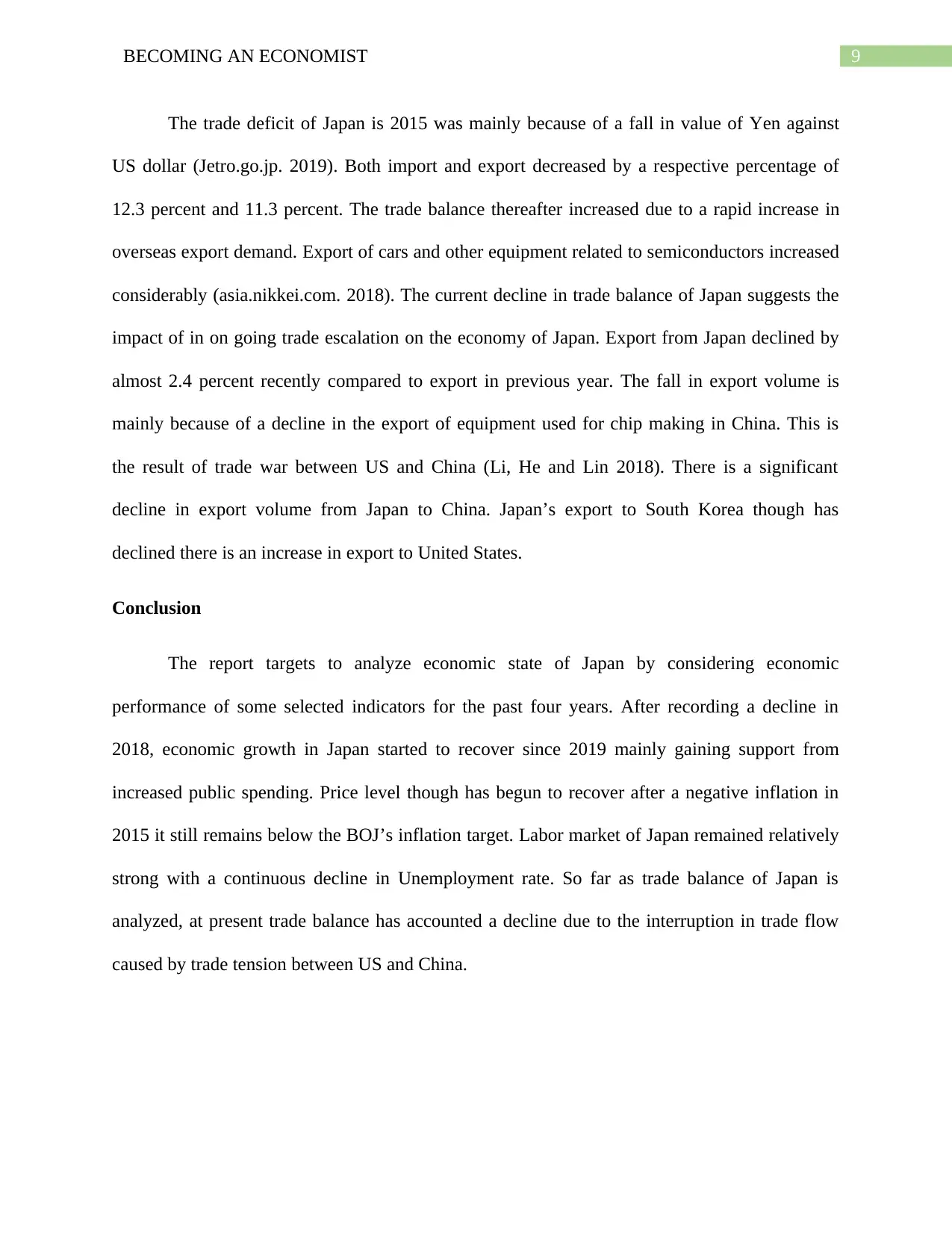
9BECOMING AN ECONOMIST
The trade deficit of Japan is 2015 was mainly because of a fall in value of Yen against
US dollar (Jetro.go.jp. 2019). Both import and export decreased by a respective percentage of
12.3 percent and 11.3 percent. The trade balance thereafter increased due to a rapid increase in
overseas export demand. Export of cars and other equipment related to semiconductors increased
considerably (asia.nikkei.com. 2018). The current decline in trade balance of Japan suggests the
impact of in on going trade escalation on the economy of Japan. Export from Japan declined by
almost 2.4 percent recently compared to export in previous year. The fall in export volume is
mainly because of a decline in the export of equipment used for chip making in China. This is
the result of trade war between US and China (Li, He and Lin 2018). There is a significant
decline in export volume from Japan to China. Japan’s export to South Korea though has
declined there is an increase in export to United States.
Conclusion
The report targets to analyze economic state of Japan by considering economic
performance of some selected indicators for the past four years. After recording a decline in
2018, economic growth in Japan started to recover since 2019 mainly gaining support from
increased public spending. Price level though has begun to recover after a negative inflation in
2015 it still remains below the BOJ’s inflation target. Labor market of Japan remained relatively
strong with a continuous decline in Unemployment rate. So far as trade balance of Japan is
analyzed, at present trade balance has accounted a decline due to the interruption in trade flow
caused by trade tension between US and China.
The trade deficit of Japan is 2015 was mainly because of a fall in value of Yen against
US dollar (Jetro.go.jp. 2019). Both import and export decreased by a respective percentage of
12.3 percent and 11.3 percent. The trade balance thereafter increased due to a rapid increase in
overseas export demand. Export of cars and other equipment related to semiconductors increased
considerably (asia.nikkei.com. 2018). The current decline in trade balance of Japan suggests the
impact of in on going trade escalation on the economy of Japan. Export from Japan declined by
almost 2.4 percent recently compared to export in previous year. The fall in export volume is
mainly because of a decline in the export of equipment used for chip making in China. This is
the result of trade war between US and China (Li, He and Lin 2018). There is a significant
decline in export volume from Japan to China. Japan’s export to South Korea though has
declined there is an increase in export to United States.
Conclusion
The report targets to analyze economic state of Japan by considering economic
performance of some selected indicators for the past four years. After recording a decline in
2018, economic growth in Japan started to recover since 2019 mainly gaining support from
increased public spending. Price level though has begun to recover after a negative inflation in
2015 it still remains below the BOJ’s inflation target. Labor market of Japan remained relatively
strong with a continuous decline in Unemployment rate. So far as trade balance of Japan is
analyzed, at present trade balance has accounted a decline due to the interruption in trade flow
caused by trade tension between US and China.
Paraphrase This Document
Need a fresh take? Get an instant paraphrase of this document with our AI Paraphraser
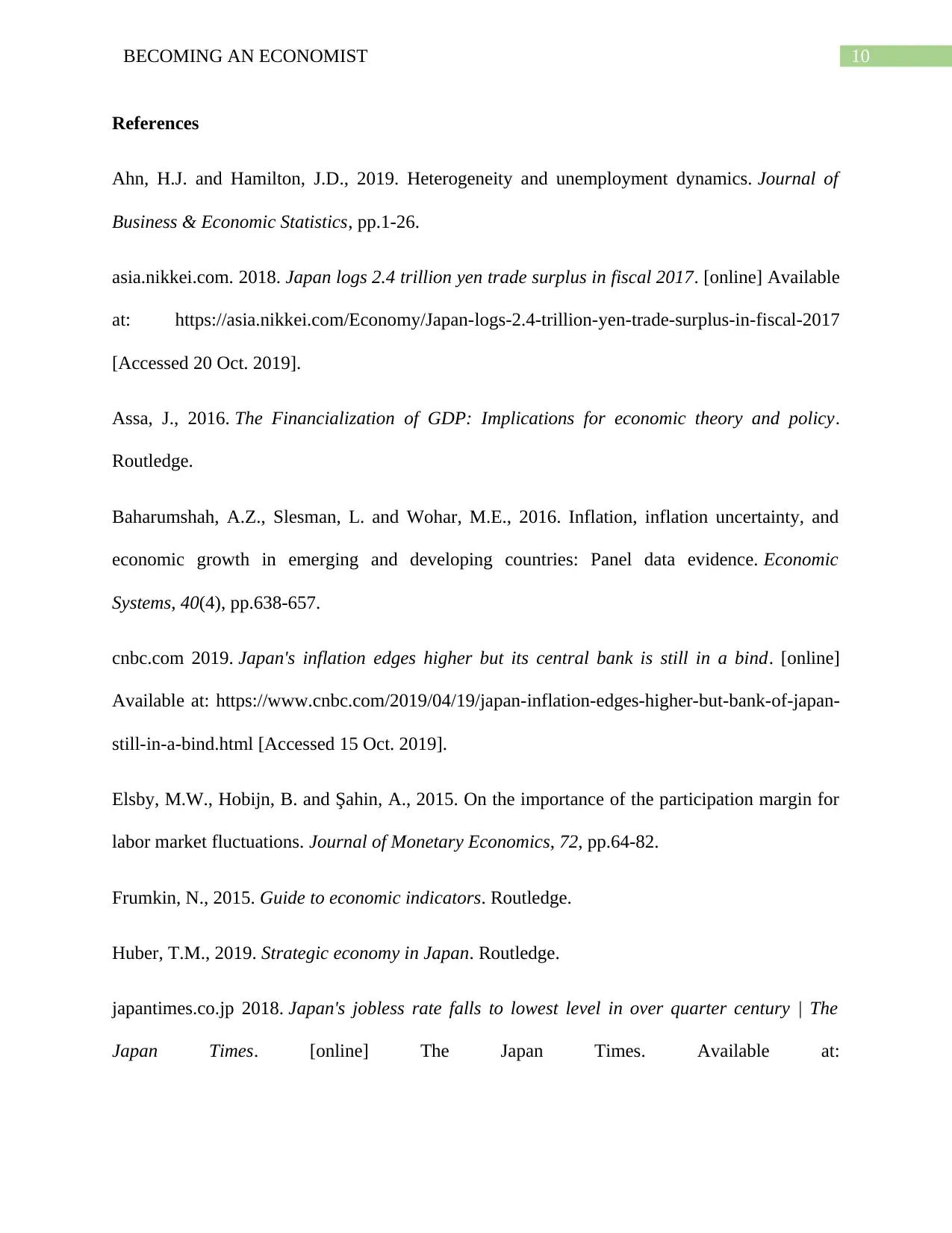
10BECOMING AN ECONOMIST
References
Ahn, H.J. and Hamilton, J.D., 2019. Heterogeneity and unemployment dynamics. Journal of
Business & Economic Statistics, pp.1-26.
asia.nikkei.com. 2018. Japan logs 2.4 trillion yen trade surplus in fiscal 2017. [online] Available
at: https://asia.nikkei.com/Economy/Japan-logs-2.4-trillion-yen-trade-surplus-in-fiscal-2017
[Accessed 20 Oct. 2019].
Assa, J., 2016. The Financialization of GDP: Implications for economic theory and policy.
Routledge.
Baharumshah, A.Z., Slesman, L. and Wohar, M.E., 2016. Inflation, inflation uncertainty, and
economic growth in emerging and developing countries: Panel data evidence. Economic
Systems, 40(4), pp.638-657.
cnbc.com 2019. Japan's inflation edges higher but its central bank is still in a bind. [online]
Available at: https://www.cnbc.com/2019/04/19/japan-inflation-edges-higher-but-bank-of-japan-
still-in-a-bind.html [Accessed 15 Oct. 2019].
Elsby, M.W., Hobijn, B. and Şahin, A., 2015. On the importance of the participation margin for
labor market fluctuations. Journal of Monetary Economics, 72, pp.64-82.
Frumkin, N., 2015. Guide to economic indicators. Routledge.
Huber, T.M., 2019. Strategic economy in Japan. Routledge.
japantimes.co.jp 2018. Japan's jobless rate falls to lowest level in over quarter century | The
Japan Times. [online] The Japan Times. Available at:
References
Ahn, H.J. and Hamilton, J.D., 2019. Heterogeneity and unemployment dynamics. Journal of
Business & Economic Statistics, pp.1-26.
asia.nikkei.com. 2018. Japan logs 2.4 trillion yen trade surplus in fiscal 2017. [online] Available
at: https://asia.nikkei.com/Economy/Japan-logs-2.4-trillion-yen-trade-surplus-in-fiscal-2017
[Accessed 20 Oct. 2019].
Assa, J., 2016. The Financialization of GDP: Implications for economic theory and policy.
Routledge.
Baharumshah, A.Z., Slesman, L. and Wohar, M.E., 2016. Inflation, inflation uncertainty, and
economic growth in emerging and developing countries: Panel data evidence. Economic
Systems, 40(4), pp.638-657.
cnbc.com 2019. Japan's inflation edges higher but its central bank is still in a bind. [online]
Available at: https://www.cnbc.com/2019/04/19/japan-inflation-edges-higher-but-bank-of-japan-
still-in-a-bind.html [Accessed 15 Oct. 2019].
Elsby, M.W., Hobijn, B. and Şahin, A., 2015. On the importance of the participation margin for
labor market fluctuations. Journal of Monetary Economics, 72, pp.64-82.
Frumkin, N., 2015. Guide to economic indicators. Routledge.
Huber, T.M., 2019. Strategic economy in Japan. Routledge.
japantimes.co.jp 2018. Japan's jobless rate falls to lowest level in over quarter century | The
Japan Times. [online] The Japan Times. Available at:
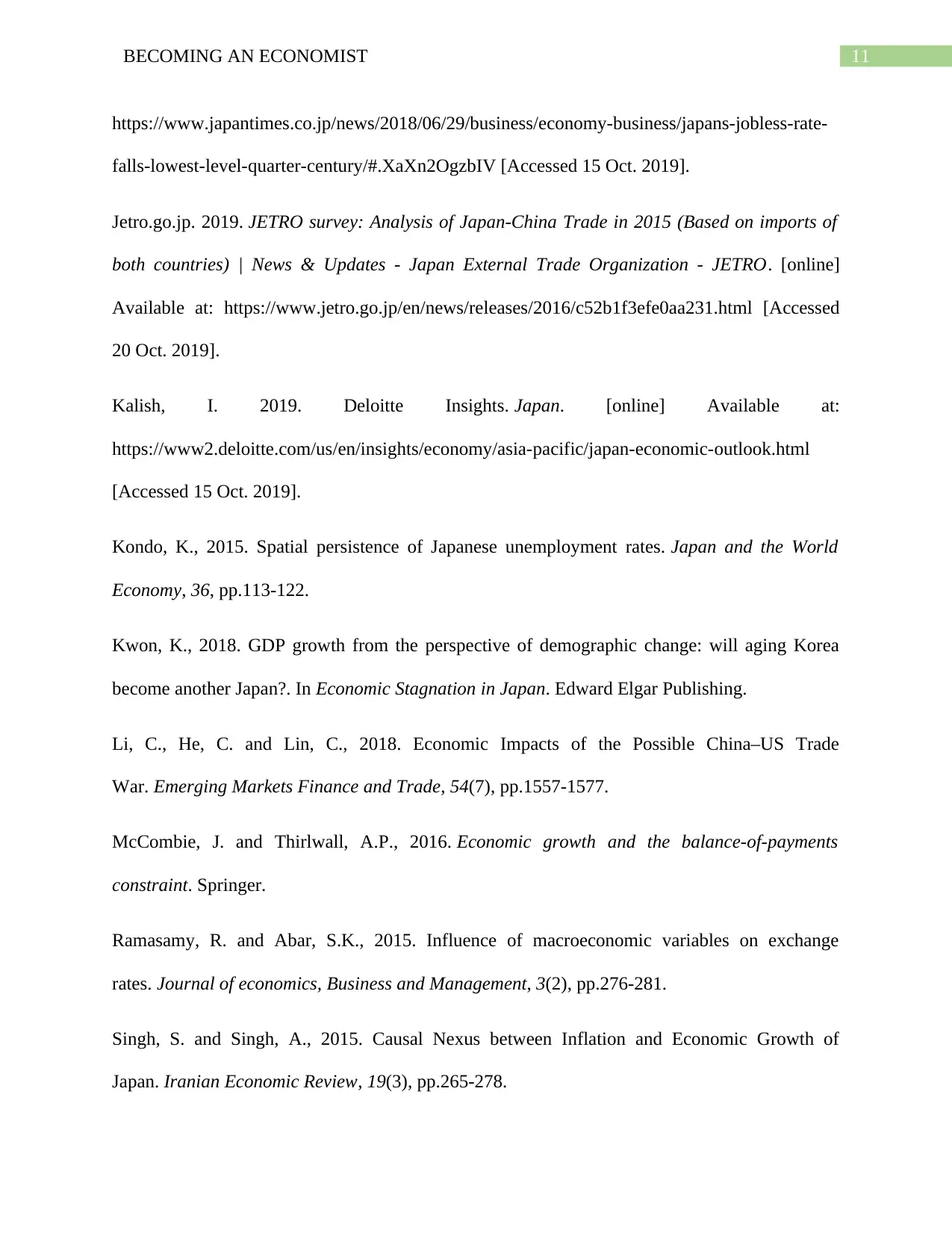
11BECOMING AN ECONOMIST
https://www.japantimes.co.jp/news/2018/06/29/business/economy-business/japans-jobless-rate-
falls-lowest-level-quarter-century/#.XaXn2OgzbIV [Accessed 15 Oct. 2019].
Jetro.go.jp. 2019. JETRO survey: Analysis of Japan-China Trade in 2015 (Based on imports of
both countries) | News & Updates - Japan External Trade Organization - JETRO. [online]
Available at: https://www.jetro.go.jp/en/news/releases/2016/c52b1f3efe0aa231.html [Accessed
20 Oct. 2019].
Kalish, I. 2019. Deloitte Insights. Japan. [online] Available at:
https://www2.deloitte.com/us/en/insights/economy/asia-pacific/japan-economic-outlook.html
[Accessed 15 Oct. 2019].
Kondo, K., 2015. Spatial persistence of Japanese unemployment rates. Japan and the World
Economy, 36, pp.113-122.
Kwon, K., 2018. GDP growth from the perspective of demographic change: will aging Korea
become another Japan?. In Economic Stagnation in Japan. Edward Elgar Publishing.
Li, C., He, C. and Lin, C., 2018. Economic Impacts of the Possible China–US Trade
War. Emerging Markets Finance and Trade, 54(7), pp.1557-1577.
McCombie, J. and Thirlwall, A.P., 2016. Economic growth and the balance-of-payments
constraint. Springer.
Ramasamy, R. and Abar, S.K., 2015. Influence of macroeconomic variables on exchange
rates. Journal of economics, Business and Management, 3(2), pp.276-281.
Singh, S. and Singh, A., 2015. Causal Nexus between Inflation and Economic Growth of
Japan. Iranian Economic Review, 19(3), pp.265-278.
https://www.japantimes.co.jp/news/2018/06/29/business/economy-business/japans-jobless-rate-
falls-lowest-level-quarter-century/#.XaXn2OgzbIV [Accessed 15 Oct. 2019].
Jetro.go.jp. 2019. JETRO survey: Analysis of Japan-China Trade in 2015 (Based on imports of
both countries) | News & Updates - Japan External Trade Organization - JETRO. [online]
Available at: https://www.jetro.go.jp/en/news/releases/2016/c52b1f3efe0aa231.html [Accessed
20 Oct. 2019].
Kalish, I. 2019. Deloitte Insights. Japan. [online] Available at:
https://www2.deloitte.com/us/en/insights/economy/asia-pacific/japan-economic-outlook.html
[Accessed 15 Oct. 2019].
Kondo, K., 2015. Spatial persistence of Japanese unemployment rates. Japan and the World
Economy, 36, pp.113-122.
Kwon, K., 2018. GDP growth from the perspective of demographic change: will aging Korea
become another Japan?. In Economic Stagnation in Japan. Edward Elgar Publishing.
Li, C., He, C. and Lin, C., 2018. Economic Impacts of the Possible China–US Trade
War. Emerging Markets Finance and Trade, 54(7), pp.1557-1577.
McCombie, J. and Thirlwall, A.P., 2016. Economic growth and the balance-of-payments
constraint. Springer.
Ramasamy, R. and Abar, S.K., 2015. Influence of macroeconomic variables on exchange
rates. Journal of economics, Business and Management, 3(2), pp.276-281.
Singh, S. and Singh, A., 2015. Causal Nexus between Inflation and Economic Growth of
Japan. Iranian Economic Review, 19(3), pp.265-278.
⊘ This is a preview!⊘
Do you want full access?
Subscribe today to unlock all pages.

Trusted by 1+ million students worldwide
1 out of 13
Related Documents
Your All-in-One AI-Powered Toolkit for Academic Success.
+13062052269
info@desklib.com
Available 24*7 on WhatsApp / Email
![[object Object]](/_next/static/media/star-bottom.7253800d.svg)
Unlock your academic potential
Copyright © 2020–2025 A2Z Services. All Rights Reserved. Developed and managed by ZUCOL.





